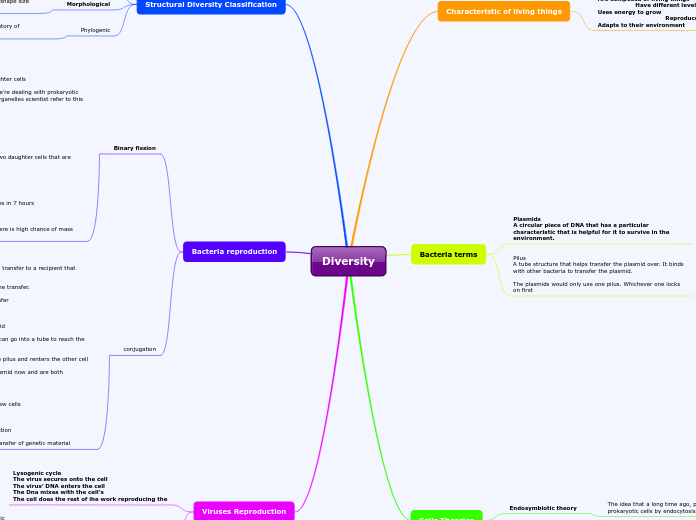
Are composed of living things
Have different levels of organisation
Uses energy to grow
Reproduce
Adapts to their environment
Plasmids
A circular piece of DNA that has a particular characteristic that is helpful for it to survive in the environment.
Pilus
A tube structure that helps transfer the plasmid over. It binds with other bacteria to transfer the plasmid.
The plasmids would only use one pilus. Whichever one locks on first
Endosymbiotic theory
The idea that a long time ago, prokaryotic cells engulfed other prokaryotic cells by endocytosis
Membrane infolding
Some of early ancestral prokaryotic cells’ cell membranes were able to fold into the cell itself
Biological
Defines a species based on the possibility of two organism interbreeding and produce fertile offspring in nature
Morphological
Defines a species based off it’s morphology- body shape size and other structural features
Phylogenic
Defines species based on the evolutionary history of organisms
Binary fission
Asexual
Only one parent is required
One cell forms two identical daughter cells
Similar to Mitosis but now that we’re dealing with prokaryotic cells without membrane bound organelles scientist refer to this as binary fission
Process
The bacterium is duplicated
The bacterial cell elongates
The bacterial cells splits into to two daughter cells that are exact duplicates of it’s parent.
Advantages
Speed
E.Coli can produce 2 million clones in 7 hours
Disadvantages
Since the clones are the same there is high chance of mass extinction
conjugation
Sexual reproduction
Donar Bacterial cell
Will duplicate it’s plasmid and transfer to a recipient that doesn’t have a plasmid
Conjugation isn’t limited to one transfer.
It can be a dual plasmid transfer
Process
The dna is made into a plasmid
The plasmid has a pilus so it can go into a tube to reach the other bacteria
The plasmid goes through the pilus and renters the other cell
Both cells would have the plasmid now and are both considered donors
Advantage
Doesn’t involve the form of new cells
Diversity
Much slower form of reproduction
Requires two cells amd the transfer of genetic material
Lysogenic cycle
The virus secures onto the cell
The virus’ DNA enters the cell
The Dna mixes with the cell’s
The cell does the rest of ihe work reproducing the
Lytic
The virus attaches to the cell
The virus enters the cell
It;s digested by the host dna and is being re made
It grows as if it is a normal protein and when released it starts the cycle once more